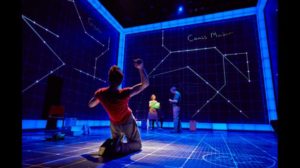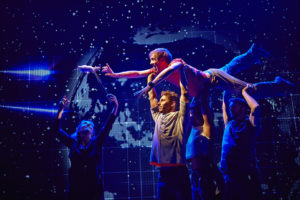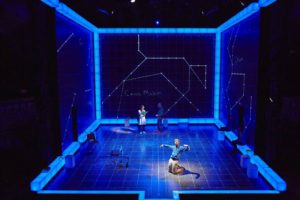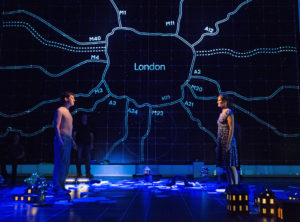
 (4 / 5)
(4 / 5)
Five years after Simon Stephens’ stage adaptation of ‘The Curious Incident of the Dog in the Night-time’ opened at the National Theatre, the 2017 production at the Wales Millennium centre did not disappoint.
Haddon’s Whitbread Prize-winning novel has made a staggeringly successful leap from popular book to stand out theatre adaption and it’s fair to say no one could have quite predicted the way audiences would take central character Christopher Boone to their hearts.
Christopher (lover of mathematics, space and detective novels – who just happens to have Asperger Syndrome) has stumbled upon a serious crime in neighbour Mrs Sheers’ garden.
Although he has never before left his street unaccompanied, the crime triggers an investigation led by Christopher himself – in between dealing with a death, a family separation, writing a book for the first time and an unforeseen journey to London which will be his most terrifying challenge yet.
Although Mark Haddon never intended for Christopher’s character to become typical of all people with ASD (Autistic Spectrum Disorder), the beauty of the book – and even more so in this play, is the level of forensic insight into some of the behaviours, motivations and traits of people on the spectrum.

The story unpicks everything we think we know about conditions on the spectrum – and in actual fact exposes some harsh truths about us as a society and how needy, shallow, patronising and ignorant we are of the needs of others. As Haddon stated in 2012: ‘Curious is not really about Christopher at all. It’s about us.’
This is a production about the imperfections and the ugliness of family – and of facing our fears. It shows us the inevitable fallout when our ideas of perfection and truth don’t match up with reality. Life is chaotic and messy – and instead Christopher finds solace and security in the permanence and predictability of patterns.
We see Christopher struggle to cope with the nuances and complications of everyday life while making sense of the confusing world around him. When things don’t go to plan, we see Christopher unravel and the environment/pool of people around him react as they try to contain his outbursts and meltdowns.

The set (beautifully designed by Bunny Christie) centres around a cube which comes to life with pulsating digital animations, square doors and stools which double as doors / cupboards / chairs / TV screens. Patterns, logic, word scrambles, number confetti and laser illustrations are punctuated with visceral sounds, white noise, echoes and musical riffs by Ian Dickinson as Christopher battles through the changes around him.
Lead Scott Reid (who plays Christopher) is incredible and I wasn’t aware of the level of movement and choreography that would feature in the production. For Christopher, life is a ‘dance’ of repetitive routines, motions, and constantly shifting movement and at its most intense and confusing, he is lifted, bounced and twirled by the ensemble cast. During one moving scene, he walks along the wall when he describes his wish to be an astronaut. Scott Graham and Steven Hoggett (part of Physical Theatre outfit ‘Frantic Assembly’) have really managed to elevate the story even more through their energetic movement and choreographed vignettes.
For some productions, the combination of digital display, choreography and a grand musical score doesn’t always marry well – you struggle to follow or invest fully in all aspects of the staging or the story and they can compete against one another. But there is true mastery here, a dynamite synergy between cast, production and set – and the scenes set in Swindon and London train stations are a sheer punch in the gut for audiences.

In this production, Director Marianne Elliott has skillfully recreated the panic and the fear of sensory overload as well as the sheer beauty of an unfiltered, orderly mind like Christopher’s. There is purity and calm in the systematic and Christopher’s observations, literal interpretations and understanding of the world provide plenty of funny moments for the audience.
Curious does not talk down, belittle or over sentimentalise ASD in a way which some mainstream depictions of ASD do and Stephens’ final scene between teacher Siobhan and Christopher leaves the audience with one final question which asks more of them and their attitudes as much as anything else.
This was a tender and sweet production – a powerful start to the production’s 2017 run at the WMC. Oh, and if you see it – you can look forward to a truly wonderful final surprise for Christopher at the end. What is it? Well, now…that would be telling!
PS – if you have already seen this production or like me have multiple members in your family with ASD and you’d like to understand why they do some of the things they do, I really recommend reading ‘The Reason I Jump’ – a real-life account from 13 year old Naoki Higashida who has Autism.
Type of show: Theatre
Title: The Curious Incident of the Dog in the Night-time
Venue: Wales Millennium Centre (Cardiff)
Dates: 2-6 May
Writer (Original Book): Mark Haddon
Play adaptation: Simon Stephens
Directed by: Marianne Elliott
Lighting Designer: Bunny Christie
Video Designer: Finn Ross
Movement Directors: Scott Graham / Steven Hoggett (Frantic Assembly)
Sound Designer: Ian Dickinson (Autograph)
Running time: 2hrs 30min
Produced by: National Theatre
Get The Chance has a firm but friendly comments policy.
